USDA Regulated Pest
coconut rhinoceros beetle, coconut beetle
Family: Scarabaeidae Subfamily: Dynastinae Genus: Oryctes Species: Oryctes rhinoceros (Linnaeus, 1758)
DNA Barcode available: specimen information
Total body length 40.0–60.0 mm (1.57–2.36 in). Body shape elongate, slightly cylindrical. Color dark brown to black. Ocular canthuscanthus:
a process extending over and sometimes dividing the eye
not produced. Head of male with long, slightly curved horn ending in single point; female with horn present but usually reduced. Pronotumpronotum:
the dorsal surface of the thorax
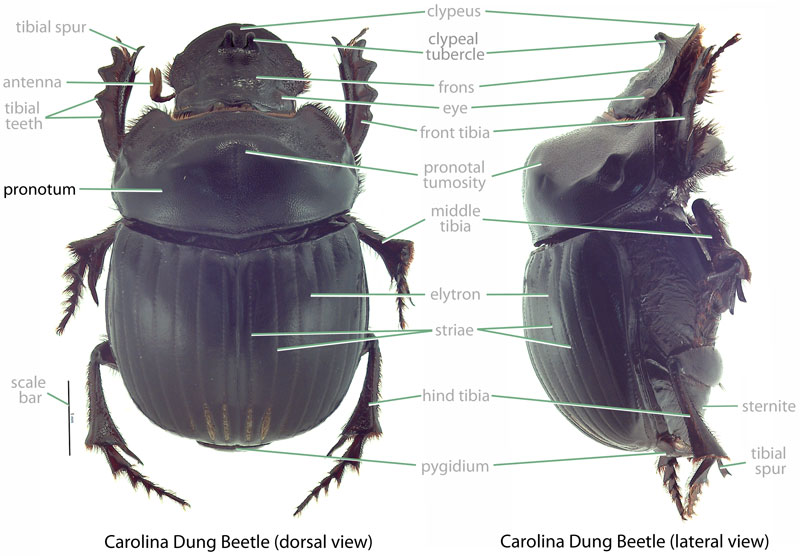 of both sexes without horns, but with broad, sculpted depression. Pygidiumpygidium:
of both sexes without horns, but with broad, sculpted depression. Pygidiumpygidium:
the last abdominal segment, usually exposed, not completely covered by the elytra
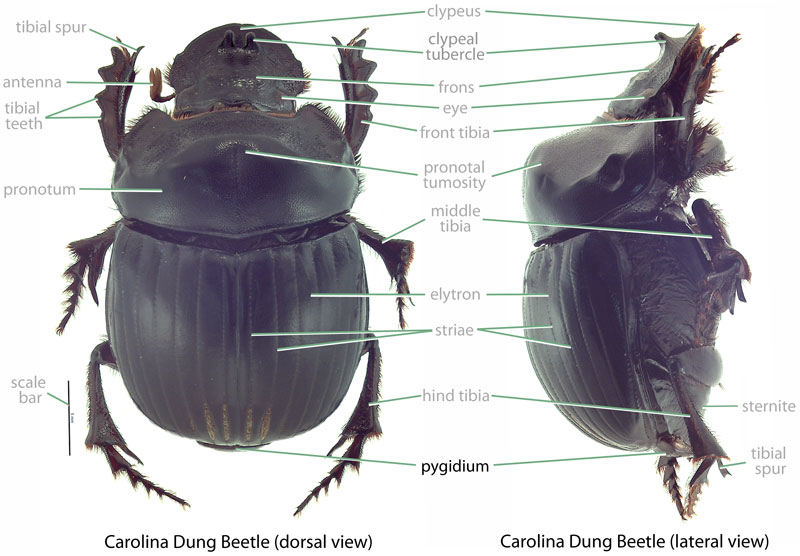 of female with dense red-brown setaesetae:
of female with dense red-brown setaesetae:
small, hair-like structure
, setaesetae:
small, hair-like structure
much more sparse in male.
(Bedford, 1974Bedford, 1974:
Bedford G. 1974. Descriptions of the larvae of some rhinoceros beetles (Coleoptera: Scarabaeidae: Dynastinae) associated with coconut palms in New Guinea. Bulletin of Entomological Research. 63: 445–47): When alive, larvaelarvae:
the immature form of an insect; in scarabs, also called grub or white grub; preceded by the egg stage, followed by the pupal stage
 are firm to the touch and crawl on their venter. Similar-sized Protaetia larvaelarvae:
are firm to the touch and crawl on their venter. Similar-sized Protaetia larvaelarvae:
the immature form of an insect; in scarabs, also called grub or white grub; preceded by the egg stage, followed by the pupal stage
 feel distinctly "squishy" and crawl on their backs with their legs up. Grub C-shaped, not hump-backed, cylindrical, and cream-colored. Maxillamaxilla:
feel distinctly "squishy" and crawl on their backs with their legs up. Grub C-shaped, not hump-backed, cylindrical, and cream-colored. Maxillamaxilla:
set of paired mouthparts located posterior to the mandibles
with galeagalea:
outer branch or lobe of the maxilla
 and lacinialacinia:
and lacinialacinia:
inner portion of the maxilla fused or nearly so. Lacinialacinia:
fused or nearly so. Lacinialacinia:
inner portion of the maxilla of maxillamaxilla:
of maxillamaxilla:
set of paired mouthparts located posterior to the mandibles
with 3 well-developed unciunci:
in scarab larvae, a hooked process on the distal margin of the maxilla
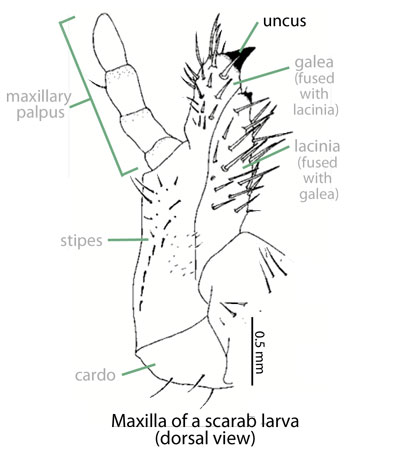 . Maxillary stridulatory teeth truncatetruncate:
. Maxillary stridulatory teeth truncatetruncate:
appearing cut-off or suddenly shortened
. Head with numerous rounded pits, most with a tiny setaseta:
small, hair-like structure
. Respiratory plate with 40–80 (sometimes more) round or oblong punctures. Legs 4-segmented. First thoracic segment with single, long setaseta:
small, hair-like structure
and 3–8 shorter setae; shorter than width of scleritesclerite:
hard, external plate of the exoskeleton
. Thoracic spiraclesspiracles:
opening on the abdomen or thorax through which air enters and exits the body
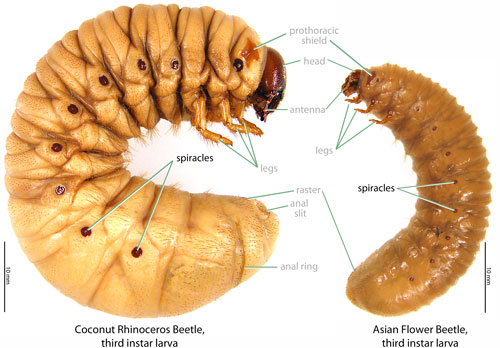 larger than abdominal spiraclesspiracles:
larger than abdominal spiraclesspiracles:
opening on the abdomen or thorax through which air enters and exits the body
 . Distinct anal ringanal ring:
. Distinct anal ringanal ring:
in scarab larvae, a distinct ring-like suture found near the posterior of some <em>Oryctes</em> species
 on terminal segment. PlegmatiaPlegmatia:
on terminal segment. PlegmatiaPlegmatia:
in scarab larvae, a paired, lateral region with a somewhat sclerotized surface bordered by marginal spines with acanthoparia
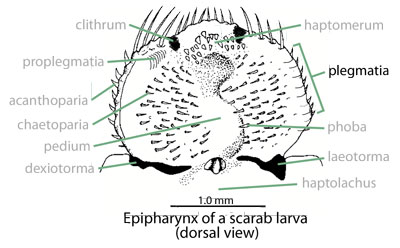 absent.
absent.
Southeastern Asia. This species has a wide distribution across tropical and subtropical southeastern Asia, ranging from India and Pakistan, through Indochina, east to Okinawa, the Philippines, and Indonesia. The species has spread widely beyond its native range and can now be found in the Bismarck Archipelago, Palau, Reunion, Samoa, Tonga, Fiji, Micronesia, Mauritius, Guam, and Hawaii (Bedford, 2015Bedford, 2015:
Bedford G. 2015. Oryctes rhinoceros (coconut rhinoceros beetle). Invasive Species Compendium. Wallingford, UK, CABI International. Available from http://www.cabi.org/isc/datasheet/37974 (accessed 2015).).
Adults of this species are best known as pests of the coconut palm (Cocos nucifera). A great many other palms are damaged by adults, including the African oil palm (Elaeis guineensis), betel nut or areca nut palm (Areca catechu), Chinese fan palm (Livistona chinensis), date palm (Phoenix dactylifera), ivory nut palm (Metroxylon amicarum), Fiji fan palm (Pritchardia pacifica), Palmyra palm (Borassus flabellifer), Pandanus spp., ruffle palm (Aiphanes horrida), royal palm (Roystonea regia), sugar palm (Arenga pinnata), and talipot palm (Corypha corypha:
in scarab larvae, the area separating the epipharynx and clithra; may be lacking in some larvae
umbraculifera). Non-palm species recorded as hosts include the Alexandria laurel (Calophyllum inophyllum), banana (Musa spp.), breadfruit (Artocarpus spp.), mango (Mangifera spp.), pineapple (Ananas comosus), and sugarcane (Saccharum spp.) (Molet, 2013Molet, 2013:
Molet T. 2013. CPHST pest datasheet for Oryctes rhinoceros . USDA-APHIS-PPQ-CPHST. Available from https://caps.ceris.purdue.edu/webfm_send/2206 (accessed April 9 2015).).
(Molet, 2013Molet, 2013:
Molet T. 2013. CPHST pest datasheet for Oryctes rhinoceros . USDA-APHIS-PPQ-CPHST. Available from https://caps.ceris.purdue.edu/webfm_send/2206 (accessed April 9 2015).): Females deposit eggs in burrows dug into mulch, decaying vegetation, manure-rich soils, or soft rotten wood. Standing, dead palms are used as breeding sites, as is rotten plant matter caught in the petiolespetioles:
stalk of a leaf
of living palms. Adults burrow as deep as 50 cm (19.7 in) into the crowns of host plants. Adults prepare the burrow for larvaelarvae:
the immature form of an insect; in scarabs, also called grub or white grub; preceded by the egg stage, followed by the pupal stage
 by covering eggs with chewed nesting medium. Females lay three or four clutches of about 30 eggs each. With favorable conditions, there may be up to three overlapping generations per year. The larval stage is 72–130 days, followed by a pre-pupal stage, and then a pupal stage that lasts 31–40 days before adult emergence. Adults are nocturnal.
by covering eggs with chewed nesting medium. Females lay three or four clutches of about 30 eggs each. With favorable conditions, there may be up to three overlapping generations per year. The larval stage is 72–130 days, followed by a pre-pupal stage, and then a pupal stage that lasts 31–40 days before adult emergence. Adults are nocturnal.
Severe. Oryctes rhinoceros is a severe and known biosecurity threat with a history of invasiveinvasive:
a species that has recently arrived to a new location, usually via human activity, causing notable economic and/or ecological damage
spread. Damage is caused when young adults bore into the crowns of host plants, burrowing as deep as 50 cm into the host tissue (Molet, 2013Molet, 2013:
Molet T. 2013. CPHST pest datasheet for Oryctes rhinoceros . USDA-APHIS-PPQ-CPHST. Available from https://caps.ceris.purdue.edu/webfm_send/2206 (accessed April 9 2015).). This often results in destruction of unopened leaves and damage of the leaf midrib (Molet, 2013Molet, 2013:
Molet T. 2013. CPHST pest datasheet for Oryctes rhinoceros . USDA-APHIS-PPQ-CPHST. Available from https://caps.ceris.purdue.edu/webfm_send/2206 (accessed April 9 2015).). After feeding on the juices produced by damaged host tissue, the beetle bores out of the host, often through the base of the frond (Molet, 2013Molet, 2013:
Molet T. 2013. CPHST pest datasheet for Oryctes rhinoceros . USDA-APHIS-PPQ-CPHST. Available from https://caps.ceris.purdue.edu/webfm_send/2206 (accessed April 9 2015).). Plants, particularly young plants, can be killed when the scarab damages the apical meristem or via secondary infection in the feeding burrow (Hinckley, 1973Hinckley, 1973:
Hinckley A. 1973. Ecology of the coconut rhinoceros beetle, Oryctes rhinoceros (L.) (Coleoptera: Dynastidae). Biotropica 5: 111-116.). In Palau, Gressitt (1953) attributed coconut palm mortality rates of 50% to damage caused by this beetle. Even when coconut palms are not killed in this manner, fruit production is adversely impacted. Estimates of fruit set reduction range from 5 to 25% (Bedford, 2015Bedford, 2015:
Bedford G. 2015. Oryctes rhinoceros (coconut rhinoceros beetle). Invasive Species Compendium. Wallingford, UK, CABI International. Available from http://www.cabi.org/isc/datasheet/37974 (accessed 2015).). LarvaeLarvae:
the immature form of an insect; in scarabs, also called grub or white grub; preceded by the egg stage, followed by the pupal stage
 of this species are not reported as pests.
of this species are not reported as pests.
Established. This species is currently established on Oahu where it was first detected in December 2013 on Pearl Harbor-Hickam Joint Base (Hawaii Department of Agriculture, 2014Hawaii Department of Agriculture, 2014:
Anonymous. 2014. Destructive beetles found on Oahu coconut trees. Hawaii Department of Agriculture. Available from http://hdoa.hawaii.gov/blog/main/crb/ (accessed May 21 2015).). Efforts are underway to eradicate the scarab and prevent its spread from Oahu. It is very likely that this destructive scarab reached Hawaii by hitchhiking on aircraft flying to Oahu from Guam, a known dispersal pattern for several other invasiveinvasive:
a species that has recently arrived to a new location, usually via human activity, causing notable economic and/or ecological damage
scarabs (Moore, 2012Moore, 2012:
Moore A. 2012. Guam as a source of new insects for Hawaii. Pacific Entomology Conference, Portland, Oregon 2012. Available from http://guaminsects.myspecies.info/sites/guaminsects.myspecies.info/files/GuamHawaiiBugConnection.pdf (accessed 2015).).
Established. Oryctes rhinoceros was first recorded in Guam in 2007 in the Tumon Bay area and has spread to the remainder of the island since that time (Moore, 2007Moore, 2007:
Moore A. 2007. Assessment of the Rhinoceros Beetle Infestation on Guam. Available from: http://guaminsects.myspecies.info/assessment-rhinoce-beetle-infestation-guam (accessed May 19 2015).). It has been suggested that the current infestation originated from the Phillipines (DeNitto et al., 2015DeNitto et al., 2015:
DeNitto G, Cannon P, Eglitis A, Glaeser J, Maffei H, Smith S. 2015. Risk and pathway assessment for the introduction of exotic insects and pathogens that could affect Hawai‘i’s native forests. US Forest Service. Full Text . (accessed 2015)).
This species has been intercepted in quarantine on multiple occasions, with at least five U.S. interceptions known (Molet, 2013Molet, 2013:
Molet T. 2013. CPHST pest datasheet for Oryctes rhinoceros . USDA-APHIS-PPQ-CPHST. Available from https://caps.ceris.purdue.edu/webfm_send/2206 (accessed April 9 2015).). Adults have been recorded on coconut "materials", military equipment and air cargo, and in potted plants (Molet, 2013Molet, 2013:
Molet T. 2013. CPHST pest datasheet for Oryctes rhinoceros . USDA-APHIS-PPQ-CPHST. Available from https://caps.ceris.purdue.edu/webfm_send/2206 (accessed April 9 2015).; Bedford, 2015Bedford, 2015:
Bedford G. 2015. Oryctes rhinoceros (coconut rhinoceros beetle). Invasive Species Compendium. Wallingford, UK, CABI International. Available from http://www.cabi.org/isc/datasheet/37974 (accessed 2015).). It has been reported that larvaelarvae:
the immature form of an insect; in scarabs, also called grub or white grub; preceded by the egg stage, followed by the pupal stage
 are able to survive in floating logs in the ocean (Molet, 2013Molet, 2013:
are able to survive in floating logs in the ocean (Molet, 2013Molet, 2013:
Molet T. 2013. CPHST pest datasheet for Oryctes rhinoceros . USDA-APHIS-PPQ-CPHST. Available from https://caps.ceris.purdue.edu/webfm_send/2206 (accessed April 9 2015).). The distribution of the species correlates with its primary host, the coconut palm. As such, it should be regarded as a serious potential threat to territories where coconut palms occur: Florida, Puerto Rico, and the U.S. Virgin Islands. Because Oryctes rhinoceros also damages other palms, it should also be regarded as a potential threat to states such as California, Arizona, Texas, Louisiana, Mississippi, Alabama, Georgia, and the Carolinas.
This large scarab could be confused with the similarly sized and colored Japanese rhinoceros beetle (Trypoxylus dichotomus) and Xylotrupes species.
Males of these species can readily be separated by examining the male head horn (Oryctes rhinoceros with a single unbranched horn that ends in single point versus Xylotrupes with a bifurcatebifurcate:
a process dividing into two points
horn that ends in two points versus T. dichotomus with a horn that is doubly bifurcatebifurcate:
a process dividing into two points
and ends in four points).
Females can be separated by examining the ocular canthuscanthus:
a process extending over and sometimes dividing the eye
(O. rhinoceros lacks a produced canthuscanthus:
a process extending over and sometimes dividing the eye
versus Xylotrupes species that have a quadrately produced canthuscanthus:
a process extending over and sometimes dividing the eye
, T. dichotomus with an acutely produced canthuscanthus:
a process extending over and sometimes dividing the eye
) and the form of the pronotal depression (O. rhinoceros with broad, sculpted depression versus Xylotrupes without an anterioranterior:
the front or forward; opposite of posterior
depression or foveafovea:
a depressed pit or indentation
and T. dichotomus with a distinct foveafovea:
a depressed pit or indentation
).
Oryctes stentor Laporte (Comte de Castelau), Scarabaeus rhinoceros Linnaeus
Prevent the spread of this USDA regulated pest by reporting your observation at our iNaturalist project.